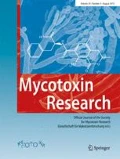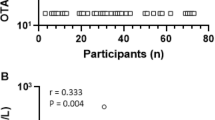Abstract
The mycotoxin ochratoxin A (OTA) and its metabolite ochratoxin alpha (OTα) were determined in milk and blood from nine lactating women who provided samples soon after delivery at a hospital in southern Chile. The analytical method applied liquid–liquid extraction with chloroform, and in the case of blood, an extra purification with solid phase extraction prior to HPLC analysis with fluorescence detection. OTA was detected in all human milk samples, with an average concentration of 106 ± 45 ng/L (range 44–184 ng/L). Levels of OTα were 40 ± 30 ng/L (LOQ 40 ng/L), but increased considerably upon enzymatic hydrolysis with ß-glucuronidase/sulfatase (up to 840 ± 256 ng/L) in human milk. By contrast, there was no evidence for conjugates of OTA. The data on OTA in breast milk and levels reported in blood from women in Chile are indicative of an efficient lactational transfer of the mycotoxin. Infant exposure to OTA was estimated by considering their daily OTA intake with human milk at early stages of nursing. For the majority of milk samples, the calculated OTA intake of infants exceeded the tolerable daily intake (TDI) of 5 ng/kg body weight (bw)/day proposed by the Nordic Expert Group, and infant exposure approached the provisional tolerable doses of 14–16 ng/kg bw/day suggested by the Joint FAO/WHO Expert Committee on Food Additives (JEFCA) and by EFSA for adults. The present study documents and confirms the presence of OTA in human milk at levels where the TDI can be exceeded. These results point out the need to continue food and biological monitoring and to develop strategies, e.g. dietary recommendations to pregnant and lactating women, aimed to reduce OTA exposure in early periods of life.



Similar content being viewed by others
References
American Academy of Pediatrics, Work Group on Breast Feeding (1997) Breast feeding and the use of human milk. Pediatrics 100(6):1035–1039
Aslam M, Beg AE, Blaszkewicz M, Degen GH, Golka K (2005) Ochratoxin A blood concentration in healthy subjects and bladder cancer cases from Pakistan. Mycotoxin Res 21(3):164–167
Boudra H, Morgavi DP (2006) Development and validation of a HPLC method for the quantitation of ochratoxins in plasma and raw milk. J Chromatogr B Biomed Appl 843:295–301
Boudra H, Barmouin J, Dragacci S, Morgavi DP (2007) Aflatoxin M1 and ochratoxin A in raw bulk milk from French dairy herds. J Dairy Sci 90(7):3197–3201
Breitholtz-Emanuelsson A, Olsen M, Oskarsson A, Palminger I, Hult K (1993a) Ochratoxin A in cow’s milk and in human milk with corresponding human blood samples. J AOAC Int 76(4):842–846
Breitholtz-Emanuelsson A, Palminger-Hallén I, Wohlin PO, Oskarsson A, Hult K, Olsen M (1993b) Transfer of ochratoxin A from lactating rats to their offspring: a short-term study. Nat Toxins 1(6):347–352
Burkhalter BR, Marin PS (1991) A demonstration of increased exclusive breastfeeding in Chile. Int J Gynecol Obstet 34:353–359
Castegnaro M, Canadas D, Vrabcheva T, Petkova-Bocharova T, Chernozemsky IN, Pfohl-Leszkowicz A (2006) Balkan endemic nephropathy: role of ochratoxins A through biomarkers. Mol Nutr Food Res 50:519–529
Degen GH (2000) Toxikologische Bewertung von Ochratoxin A: Offene Fragen und Forschungsbedarf. Mycotoxin Res 16A:117–122
Degen GH, Meifort J, Blaszkewicz M (2005) Pilotstudie zum Biomonitoring für Ochratoxin A bei Beschäftigten im Getreide-und Rohkaffee-Umschlag. Mycotoxin Res 21(3):168–171
Degen GH, Mayer S, Blaszkewicz M (2007) Biomonitoring of ochratoxin A in grain workers. Mycotoxin Res 23(2):88–93
Dostal A, Jakusova L, Cajdiva J, Hudeckova H (2008) Results of the first studies of occurrence of ochratoxin A in human milk in Slovakia. Bratisl Lek Listy 109(6):276–278
Doster RC, Sinnhuber RO (1972) Comparative rates of hydrolysis of ochraoxins A and B in vitro. Food Cosmet Toxicol 10:389–394
EC (European Commission) (2002a) Commission Regulation No 472/2002 of 12 March 2002 amending Regulation (EC) No 466/2001 setting maximum levels for certain contaminants in foodstuffs, L 75:18–20
EC (European Commission) (2002b) Assessment of dietary intake of ochratoxin A by the population of EU Member States. Report of the Scientific Cooperation, Task 3.2.7. Directorate-General Health and Consumer Protection, European Commission. Available at URL: europa.eu.int/comm/food/fs/scoop/3.2.7_en.pdf.
EC (European Commission) (2005) Commission Regulation No 126/2005 of 26 January 2005 amending Regulation (EC) No 466/2001 as regarding ochratoxin A, L 25:3–5
EFSA (2006) European Food Safety Authority; opinion of the scientific panel on contaminants in the food chain on a request from the commission related to ochratoxin A in food. The EFSA Journal 365:1–56
Galvano F, Pietri A, Bertuzzi T, Gagliardi L, Ciotti S, Luisi S, Bognanno M, La Fauci L, Iacopino AM, Nigro F, Li Volti G, Vanella L, Giammanco G, Tina GL, Gazzolo D (2008) Maternal dietary habits and mycotoxin occurrence in human mature milk. Mol Nutr Food Res 52(4):496–501
Gareis M, Märtlbauer E, Bauer J, Gedek B (1988) Determination of ochratoxin A in human milk. Z Lebensm Unters Forsch 186(2):114–117
Gürbay A, Girgin G, Atasayar S, Sahin G, Yurdakök M, Yigit S, Tekinalp G (2009) Ochratoxin A: is it present in human breast milk samples obtained mothers from Ankara, Turkey. Toxicol Lett 189(1):S232
IARC (1993) Ochratoxin A. Some naturally occurring substances: food items and constituents, heterocyclic aromatic amines and mycotoxins. IARC monograph on the evaluation of carcinogenic risk to humans, Lyon Vol. 56, pp. 489–521
Jansen J, de Weerth C, Rksen-Walraven M (2008) Breastfeeding and the mother-infant relationship-a review. Dev Rev 28:503–521
JECFA (1996) Forty-fourth meeting of the joint FAO/WHO expert committee on food additives. Toxicological evaluation of certain food additives and contaminants in food: ochratoxin A. WHO Food Addit Ser 35:363–376
JECFA (2001) Joint FAO/WHO Expert Committee on Food Additives, Ochratoxin A, safety evaluation of certain mycotoxins in food; WHO Food Additives Series 47; FAO Food and Nutrition Paper 74; WHO, p. 281–387. http://www.inchem.org/pages/jecfa.html
Kovács F, Sándor G, Ványi A, Domány S, Zomborszky-Kovács M (1995) Detection of ochratoxin a in human blood and colostrum. Acta Vet Hung 43(4):393–400
Krogh P, Hald B, Pedersen EJ (1973) Occurrence of ochratoxin and citrinin in cereals associated with mycotoxin porcine nephropathy. Acta Pathol Microbiol Scand B 81:689–695
Kuiper-Goodman T (1991) Risk assessment of ochratoxin A residues in food. IARC Sci Publ 115:307–320
LaKind JS, Amina Wilkins A, Berlin CM Jr (2004) Environmental chemicals in human milk: a review of levels, infant exposures and health, and guidance for future research. Toxicol Appl Pharmacol 198(2):184–208
Madhyastha MS, Marquardt RR, Fröhlich AA (1992) Hydrolysis of ochratoxin A by the microbial activity of digesta in the gastrointestinal tract. Arch Environ Contam Toxicol 23:468–472
Micco C, Miraglia M, Brera C, Corneli S, Ambruzzi A (1995) Evaluation of ochratoxin A level in human milk in Italy. Food Addit Contam 12:351–354
Miraglia M, de Dominicis A, Brera C, Corneli S, Cava E, Menghetti E, Miraglia E (1995) Ochratoxin A levels in human milk and related food samples: an exposure assessment. Nat Toxins 3:436–444
Muñoz K, Vega M, Rios G, Muñoz S, Madariaga R (2006) Preliminary study of Ochratoxin A in human plasma in agricultural zones of Chile and its relation to food consumption. Food Chem Toxicol 44:1884–1889
Muñoz K, Vega M, Opazo A (2007) Ochratoxin A in pork meat at the Chilean retail market. 29th Mycotoxin Workshop May 14–16, 2007, Fellbach, Abstract Book, page 103 (P-47)
Muñoz K, Blaszkewicz M, Degen HG (2009) Simultaneous analysis of ochratoxin A and its major metabolite ochratoxin alpha in plasma and urine for an advanced biomonitoring of the mycotoxin. J Chromatogr B, Biological Monitoring and Analytical Toxicology in Occupational and Environmental Medicine. (in press)
NNT, The Nordic Working Group on Food Toxicology and Risk Evaluation (1991) Health evaluation of ochratoxin A in food products. Nordiske Seminar og Arbejdsrapporter 545. Nordic Council of Ministers, Copenhagen, Denmark
Pena A, Seifrtová M, Lino C, Silveira I, Solich P (2006) Estimation of ochratoxin A in portuguese population: new data on the occurrence in human urine by high performance liquid chromatography with fluorescence detection. Food Chem Toxicol 44(9):1449–1454
Pitout MJ (1969) The hydrolysis of ochratoxin A by some proteolytic enzymes. Biochem Pharmacol 18(2):485–491
Postupolski J, Karłowski K, Kubik P (2006) Ochratoxin a in maternal and foetal blood and in maternal milk. Rocz Panstw Zakl Hig 57(1):23–30
Ringot D, Chango A, Schneider Y-J, Larondelle Y (2006) Toxicokinetics and toxicodynamics of ochratoxin A, an update. Chem Biol Interact 159:18–46
SCF (1998) Scientific Committee on Food Opinion on Ochratoxin A, CS/CNTM/MYC/14 final, Annex II to Document XXIV/2210/98, European Commission, Bruxelles, 17th September 1998. (cited in Galvano et al. 2008)
Scott PM (2005) Biomarkers of human exposure to ochratoxin A. Food Addit Contam 1:99–107
Skaug MA (1999) Analysis of Norwegian milk and infant formulas for ochratoxin A. Food Addit Contam 16(2):75–78
Skaug MA, Størmer FC, Saugstad OD (1998) Ochratoxin A: a naturally occurring mycotoxin found in human milk samples from Norway. Acta Paediatr 87(12):1275–1278
Skaug MA, Helland I, Solvoll K, Saugstad OD (2001) Presence of ochratoxin A in human milk in relation to dietary intake. Food Addit Contam 18(4):321–327
Solomon GM, Weiss PM (2002) Chemical contaminants in breast milk: time trends and regional variability. Environ Health Perspect 100(6):339–347
Studer-Rohr I, Schlatter J, Dietrich DR (2000) Kinetic parameters and intraindividual fluctuations of ochratoxin A plasma levels in humans. Arch Toxicol 74:499–510
Turconi G, Guarcello M, Livieri Ch, Comizolli S, Maccarini L, Castellazzi AM, Pietri A, Piva G, Roggi C (2004) Evaluation of xenobiotics in human milk and ingestion by the newborn. An epidemiological survey in Lombardy (Northern Italy). Eur J Nutr 43:191–197
Valenta H, Goll M (1996) Determination of ochratoxin A in regional samples of cow’s milk from Germany. Food Addit Contam 13(6):669–676
Vatinno R, Sresta A, Zambonin CG, Palmisano F (2007) Determination of ochratoxin A in human urine by solid phase microextraction coupled with liquid chromatography-fluorescence detection. J Pharm Biomed Anal 44:1014–1018
Van Egmond HP, Schothorst RC, Jonker MA (2007) Regulations relating to mycotoxins in food. Anal Bioanal Chem 389:147–157
Vega M, Muñoz K, Sepúlveda C, Aranda M, Campos V, Villegas R, Villarroel O (2009) Solid-phase extraction and HPLC determination of Ochratoxin A in cereals products on Chilean market. Food Control 20(7):631–634
Vrabcheva T, Usleber E, Dietrich R, Märtlbauer E (2000) Co-occurrence of ochratoxin A ad citrinin in cereals from Bulgarian villages with a history of balkan endemic nephropathy: a 1 month follow-up study. J Agric Food Chem 48:2483–2488
WHO/UNICEF (1990) Innocenti declaration on the protection, promotion and support of breastfeeding, adopted Florence, Italy, 1 August 1990
Xiao H, Marquardt RR, Abramson D, Frohlich A (1996) Metabolites of ochratoxin A in rat urine and in a culture of Aspergillus ochraceus. Appl Environ Microbiol 62(2):648–655
Zimmerli B, Dick R (1995) Determination of ochratoxin A at the ppt level in human blood, serum, milk and some foodstuffs by high-performance liquid chromatography with enhanced fluorescence detection and immunoaffinity column cleanup: methodology and Swiss data. J Chromatogr B Biomed Appl 666(1):85–99
Zohair A, Salem AB (2006) A study of human exposure to ochratoxin A in a selected population of Egypt. American-Eurasian J Agric & Environ Sci 1(1):19–25
Acknowledgements
The authors want to thank the midwives Verónica Moreno V. and Barbara Rubilar R. from the Higueras Hospital in Talcahuano, Chile, and Cecilia Urrutia for their help by collecting samples, and Iris Glaeser, Michael Porta and Gabi Baumhoer (IfADo) for their technical help. Finally, we want to thank DAAD and CONICYT for their support by a stipend to K.M.
Author information
Authors and Affiliations
Corresponding author
Rights and permissions
About this article
Cite this article
Muñoz, K., Campos, V., Blaszkewicz, M. et al. Exposure of neonates to ochratoxin A: first biomonitoring results in human milk (colostrum) from Chile. Mycotox Res 26, 59–67 (2010). https://doi.org/10.1007/s12550-009-0040-0
Received:
Revised:
Accepted:
Published:
Issue Date:
DOI: https://doi.org/10.1007/s12550-009-0040-0




